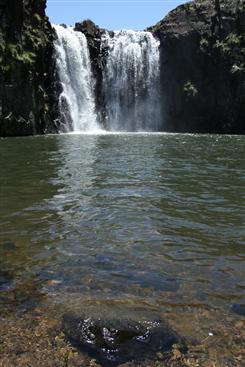The dominant influence on the future value of water in southern Africa is availability— supply in relation to demand. As the basin approaches closure, implementation of Water Conservation and Water Demand Management (WC/WDM) initiatives are urgently required. Unless WC/WDM measures are implemented, many will suffer from inadequate water resources within the next 20–30 years. Water is pivotal to economic growth and sustainable livelihoods for the people of the Orange-Senqu River basin.
Water requirements depend largely on the climate, the character of the economy and the standard of living (DWAF 2003a-e). Given a scenario in which the basin’s population continues to grow and there is a more equitable distribution of wealth, the requirement for water will increase. This will put further pressure on water resources, especially in industrialised urban areas, as many migrate towards these areas in search of jobs and better livelihoods. The Gauteng region of South Africa is likely to be most affected, considering its many mines, power stations, refineries, and urban centres.
Current investigations indicate that climate change will be a very influential factor, increasing both the frequency and the intensity of droughts in the basin (see the box below). The drier western parts of the basin are likely to be the most affected, which may in turn affect food security, as the western parts (Upper and Lower WMAs) account for much of South Africa’s agricultural produce.
Box: Climate Change is a Major Issue in Southern Africa
Climate change poses a serious threat to ecosystems and human well-being in Southern Africa, both in the medium and long-term. Ranges in temperature rise of 2 to 6º C are projected for the next 100 years, accompanied by changes in precipitation patterns, rises in sea-level and increased frequencies of extreme events (droughts and floods). These changes are projected to have serious impacts on human welfare as well as other forms of life. While the exact nature of the changes is not known, there is general agreement about general trends as simulated by global climate models using a consistent set of emission scenarios according to the latest Intergovernmental Panel on Climate Change (IPCC) social economic scenarios.
Although model results vary, there is a general consensus for increased rainfall in East Africa and drying in southwest Africa. Future changes in mean seasonal rainfall in Africa are less well defined. Under the most rapid global warming scenario, increasing areas of Africa experience changes in summer or winter rainfall that exceed the level of natural variability. Large areas of equatorial and East Africa may experience increases in December–February rainfall of 50–100%, with decreases in June–August over parts of the Horn of Africa. There are some predicted June–August rainfall increases for the Sahel.
Climate change could severely impact upon water resources, already scarce in the southern part of the region. Higher temperatures increase evaporative demand even if rainfall remains unchanged, however the balancing effect of simultaneously rising carbon dioxide is not fully understood. Increased incidence of droughts would pose obvious hardships on all systems. Increased rainfall intensity and flooding can destroy agricultural systems, as well as infrastructure for transport and irrigation. Water management in internationally shared catchments is likely to be most affected by governance issues rather than water quantity as affected by changes in climate.
Source: Biggs et al., 2004
The basin countries will need to resolve some common issues to ensure an adequate supply of water in future at a reasonable cost (Eales et al. no date):
- A looming water shortage
- Little popular awareness that regional water resources are finite, coupled with a widespread perception that government has the ability to provide abundant water
- Inappropriate tariff structures, poor cost recovery, and problems of getting users to pay for the water supplies
- An emphasis on installation of water-supply systems, rather than on their maintenance
- Inadequate water-management education, training, and support for rural users
- Serious environmental degradation problems, particularly relating to rural land management
- Poor coordination among water-management agencies
- Inadequate attention to sanitation
- Pollution related to agricultural runoff, acid-rock drainage from mines, and poor sanitation
Increased pressure on water resources will increase the value of water in the Orange-Senqu River basin. As Governments try to mitigate problems by constructing transfer schemes, upgrading infrastructure, implementating WC/WDM initiatives, and so on, water tariffs will be increased. Water allocation mechanisms will also have to be reviewed to favour economically beneficial activities.
 An ephemeral stream during the dry season. Source:Department of Water Affairs (DWA), South Africa 2005 ( click to enlarge ) |
 Sehlabathebe National Park – a park worth conserving. Source:©iStockphoto/Ananiadis 2008 ( click to enlarge ) |
